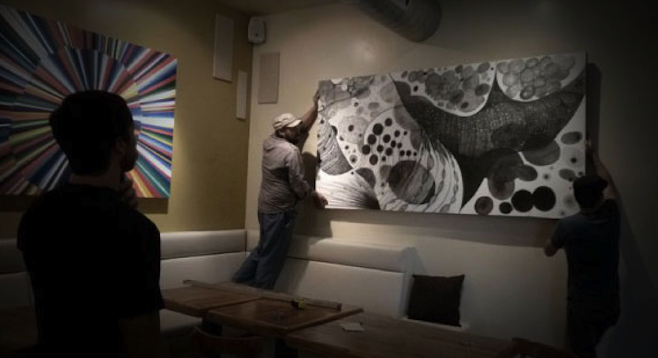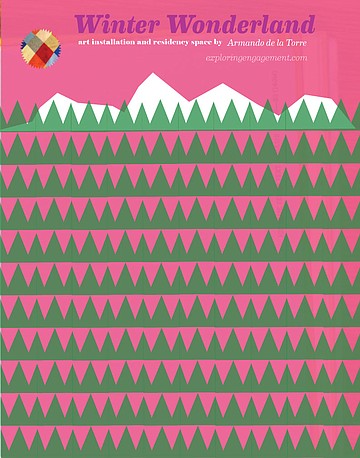 Facebook
Facebook
 X
X
 Instagram
Instagram
 TikTok
TikTok
 Youtube
Youtube

Armando de la Torre’s residence at the Oceanside Museum of Art (made possible through a James Irvine Foundation grant) begins this holiday season. The grant is supposed to provide for artists to explore ideas of community engagement, which is right in de la Torre’s wheelhouse.
“I’’m going to be getting a retail space in the Westfield mall in Carlsbad,” says de la Torre. “I’m really looking forward to engaging with people. I hope that the exhibit will draw people in and have them come back.”
His exhibit, called “Winter Wonderland,” will examine ideas of consumerism and how it relates to the wild explosion of holiday shopping. It opens on the ominous Black Friday, which is hell for some, heaven for others, and indicative to all of a “shopper” culture that many people would identify with the American middle-class.

“I kind of promised them a lot,” he laughs, knowing that preparations have just begun for “Winter Wonderland” and that there are a lot of aspects waiting to be brought into play.
De la Torre doesn’t describe himself as “totally anti-business,” and in fact sees “Winter Wonderland” as an opportunity to present an alternative vision of holiday shopping, one that focuses on art and artists, and engagement with local communities.
Ideas of community drive de la Torre as an artist. He recently moved into a huge house in Barrio Logan with people he knows through the arts and time spent at Space4Art. He has a connection to Barrio Logan through working in the neighborhood in the past with various groups, and he wants to move his artwork from the local community outwards.
“I’ve been searching for common ground in my work...and to connect people,” he says. “At least to start that conversation of ‘this is who we are from this community. These are our interests.’ How do we find that common ground so that people can understand what’s going on in different parts of the community?
“There’s a bunch of interesting stuff going on in Barrio Logan that connects neighborhoods. You have this magical corridor starting in Barrio, then you go up 25th to Golden Hill. From Golden Hill you go over to South Park, and, of course, South Park goes to North Park.”
In a way, Barrio is the southern terminus of a cultural corridor and it represents the space where neighborhoods are, to use de la Torre’s term, “slipping into darkness” and shipyards.
“Winter Wonderland”’s examination of the relationship between community, art, and business doesn’t come out of nowhere. De la Torre professes an admiration of Bob Sinclair, the original owner of Cafe Moto and Pannikin who died in a 2009 motorcycle crash. Sinclair invested his money in small communities, and not always purely for the sake of profit.
“He was an interesting San Diego personality,” says de la Torre. “He kind of shaped that whole area of Downtown [the East Village] by making an investment in the neighborhood. Mostly, I just think he was a cool dude.”
Where many artists see businesses as wholly predatory, de la Torre is awake to the reality that people in local communities are often trying to make their way in the world. “How am I going to get paid” is a very real question for so many citizens. Artists are like small businessmen trying to carve out a niche for themselves. At best, they can hope to serve the people around them rather than take advantage. He cites injustices—social, environmental, cultural, and financial—that must be overturned, and says that the best way to do so is to foster connections between people.
“We try to make our work meaningful somehow,” says de la Torre in an attempt to describe life as an artist, “and it’s mostly about connecting with people. Connecting with all kinds of people, not just a particular group. Understanding. Compassion. Humanity. Those are the things we need to cultivate.
“We’re trying to make the world more human, right?”


Armando de la Torre’s residence at the Oceanside Museum of Art (made possible through a James Irvine Foundation grant) begins this holiday season. The grant is supposed to provide for artists to explore ideas of community engagement, which is right in de la Torre’s wheelhouse.
“I’’m going to be getting a retail space in the Westfield mall in Carlsbad,” says de la Torre. “I’m really looking forward to engaging with people. I hope that the exhibit will draw people in and have them come back.”
His exhibit, called “Winter Wonderland,” will examine ideas of consumerism and how it relates to the wild explosion of holiday shopping. It opens on the ominous Black Friday, which is hell for some, heaven for others, and indicative to all of a “shopper” culture that many people would identify with the American middle-class.

“I kind of promised them a lot,” he laughs, knowing that preparations have just begun for “Winter Wonderland” and that there are a lot of aspects waiting to be brought into play.
De la Torre doesn’t describe himself as “totally anti-business,” and in fact sees “Winter Wonderland” as an opportunity to present an alternative vision of holiday shopping, one that focuses on art and artists, and engagement with local communities.
Ideas of community drive de la Torre as an artist. He recently moved into a huge house in Barrio Logan with people he knows through the arts and time spent at Space4Art. He has a connection to Barrio Logan through working in the neighborhood in the past with various groups, and he wants to move his artwork from the local community outwards.
“I’ve been searching for common ground in my work...and to connect people,” he says. “At least to start that conversation of ‘this is who we are from this community. These are our interests.’ How do we find that common ground so that people can understand what’s going on in different parts of the community?
“There’s a bunch of interesting stuff going on in Barrio Logan that connects neighborhoods. You have this magical corridor starting in Barrio, then you go up 25th to Golden Hill. From Golden Hill you go over to South Park, and, of course, South Park goes to North Park.”
In a way, Barrio is the southern terminus of a cultural corridor and it represents the space where neighborhoods are, to use de la Torre’s term, “slipping into darkness” and shipyards.
“Winter Wonderland”’s examination of the relationship between community, art, and business doesn’t come out of nowhere. De la Torre professes an admiration of Bob Sinclair, the original owner of Cafe Moto and Pannikin who died in a 2009 motorcycle crash. Sinclair invested his money in small communities, and not always purely for the sake of profit.
“He was an interesting San Diego personality,” says de la Torre. “He kind of shaped that whole area of Downtown [the East Village] by making an investment in the neighborhood. Mostly, I just think he was a cool dude.”
Where many artists see businesses as wholly predatory, de la Torre is awake to the reality that people in local communities are often trying to make their way in the world. “How am I going to get paid” is a very real question for so many citizens. Artists are like small businessmen trying to carve out a niche for themselves. At best, they can hope to serve the people around them rather than take advantage. He cites injustices—social, environmental, cultural, and financial—that must be overturned, and says that the best way to do so is to foster connections between people.
“We try to make our work meaningful somehow,” says de la Torre in an attempt to describe life as an artist, “and it’s mostly about connecting with people. Connecting with all kinds of people, not just a particular group. Understanding. Compassion. Humanity. Those are the things we need to cultivate.
“We’re trying to make the world more human, right?”
Comments